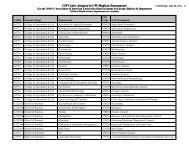Comm A and Comm B Satisfaction - Academic Planning and ...
Comm A and Comm B Satisfaction - Academic Planning and ...
Comm A and Comm B Satisfaction - Academic Planning and ...
You also want an ePaper? Increase the reach of your titles
YUMPU automatically turns print PDFs into web optimized ePapers that Google loves.
equirements within their first two terms at UW‐Madison. Although not definitive, this suggests that the<br />
reason for the mis‐sequencing is because these students were unable to register for a <strong>Comm</strong>unication A<br />
course during their first semester. Although small in number, these students would be the ones most<br />
negatively affected by a forced sequencing.<br />
The other pattern of note within the out‐of‐sequence group of students is when students delay taking a<br />
<strong>Comm</strong>unication A course, often until the same term they graduate. For this small group of students, 5%<br />
(13 students) satisfied the <strong>Comm</strong>unication A requirement sometime after their 8 th term at UW‐Madison.<br />
Although the data in this analysis cannot discern reason, we do wonder if these students “forgot” about<br />
<strong>Comm</strong>unication A, possibly delaying their graduation? Developing a better underst<strong>and</strong>ing of this type of<br />
student is a potential area for follow up <strong>and</strong> intervention.<br />
Thus far, analysis of sequencing issues has dealt only with students who graduated because these are<br />
the only students who must have completed both <strong>Comm</strong>unication A <strong>and</strong> B. What about the sequencing<br />
patterns of <strong>Comm</strong>unication A <strong>and</strong> <strong>Comm</strong>unication B for students who did not graduate? For nongraduates<br />
who completed both <strong>Comm</strong>unication A <strong>and</strong> B before “leaving” UW‐Madison, their sequencing<br />
patterns of <strong>Comm</strong>unication A <strong>and</strong> <strong>Comm</strong>unication B are similar to those of graduates (Appendix 3).<br />
Final Grades in <strong>Comm</strong>unication B Courses by Sequencing Patterns<br />
The UGEC is interested in underst<strong>and</strong>ing how students who mis‐sequence <strong>Comm</strong>unication A <strong>and</strong> B<br />
perform in <strong>Comm</strong>unication B courses. Although this question is straightforward, the analysis is not.<br />
Students in this analytic cohort took 51 different <strong>Comm</strong>unication B courses/sections, resulting in a very<br />
small analytic population in each course. Furthermore, several of the more common <strong>Comm</strong>unication B<br />
courses have significantly different grading distributions compared to other <strong>Comm</strong>unication B courses.<br />
Moreover, grading distributions sometimes vary by section within the same course. In short, finding an<br />
“apples to apples” comparison group of students who took the same <strong>Comm</strong>unication B course with the<br />
same section with the same instructor proved difficult. An additional complication is that the final<br />
grades in <strong>Comm</strong>unication B courses are a mix of the discipline‐specific content AND the <strong>Comm</strong>unication<br />
B curriculum. Final grades do not differentiate these components <strong>and</strong> thus offer limited comparability<br />
for this kind of analysis.<br />
To illustrate these challenges, we show (Table 1) the final grades of the only two courses taken by<br />
students in these cohorts where there are 10 or more students in each analytic group ‐ one group of<br />
students took their first <strong>Comm</strong>unication B course after their <strong>Comm</strong>unication A course <strong>and</strong> another who<br />
took <strong>Comm</strong>unication A after <strong>Comm</strong>unication B or at the same time. These courses are Geography 101 –<br />
Introduction to Human Geography <strong>and</strong> Chemistry 108 – General Chemistry (which offers<br />
<strong>Comm</strong>unication B at the section level).<br />
If mis‐sequencing of <strong>Comm</strong>unication A <strong>and</strong> <strong>Comm</strong>unication B leads to difficulty in <strong>Comm</strong>unication B<br />
courses then we expect to find a higher proportion of adverse outcomes (Ds <strong>and</strong> Fs) <strong>and</strong> a lower<br />
proportion of high grades in <strong>Comm</strong>unication B courses for students who did not complete<br />
<strong>Comm</strong>unication A before <strong>Comm</strong>unication B. However, for these two course comparisons, we actually<br />
see fewer mis‐sequenced students with Ds <strong>and</strong> Fs <strong>and</strong> a higher proportion with As. The already‐small<br />
number of students who take the <strong>Comm</strong>unication A <strong>and</strong> B courses out of sequence coupled with the<br />
lack of evidence of any harm in doing so leads us to assert that the effort to enforce sequencing for the<br />
<strong>Comm</strong>unication A <strong>and</strong> B requirements lacks justification considering the amount of administrative effort<br />
that would be required for enforcement.<br />
5 May 2010: <strong>Academic</strong> <strong>Planning</strong> <strong>and</strong> Analysis, Office of the Provost, clh



